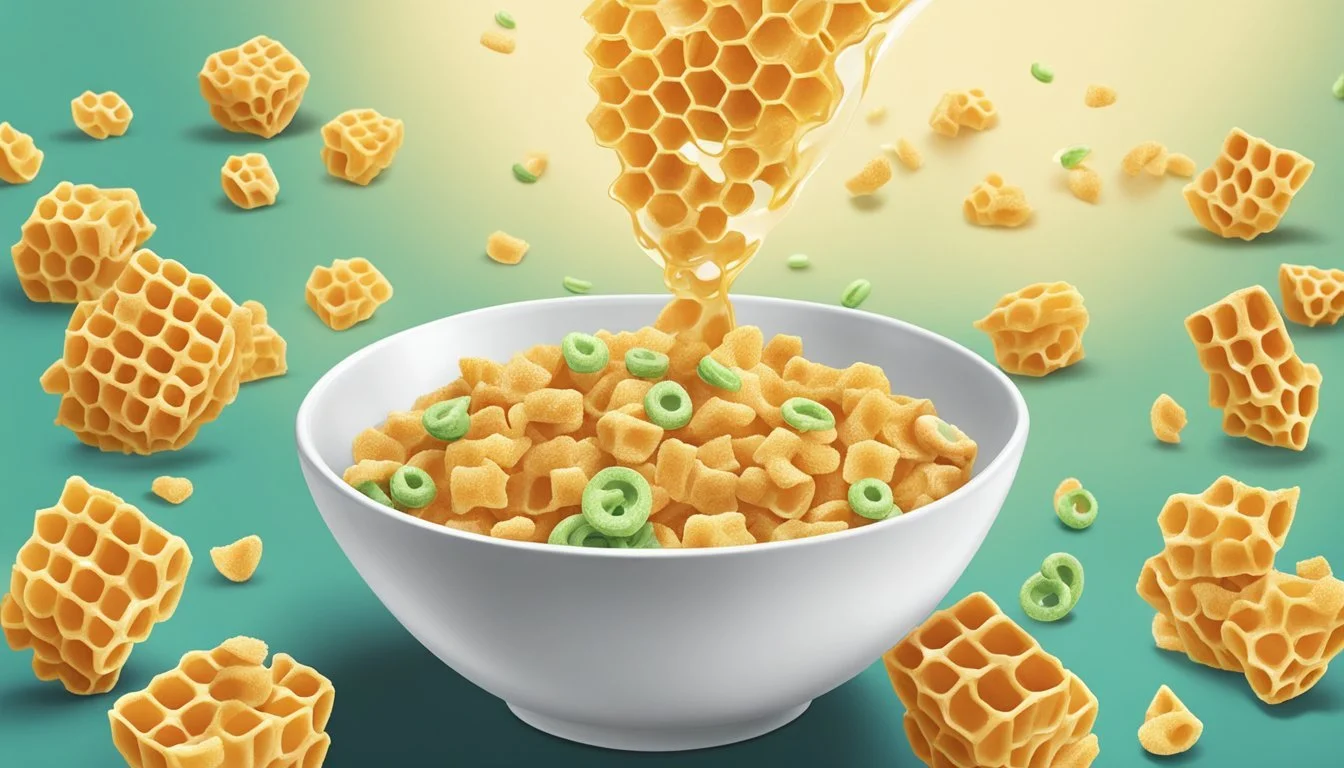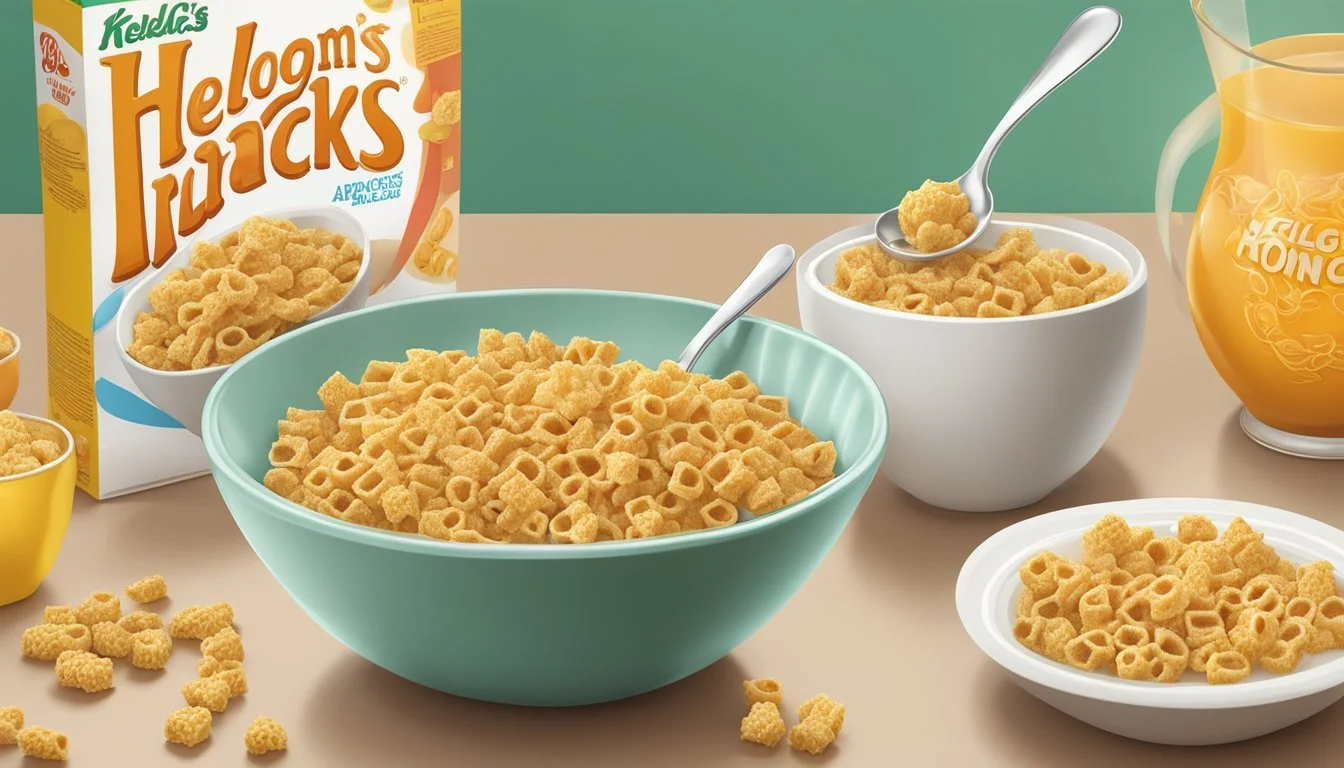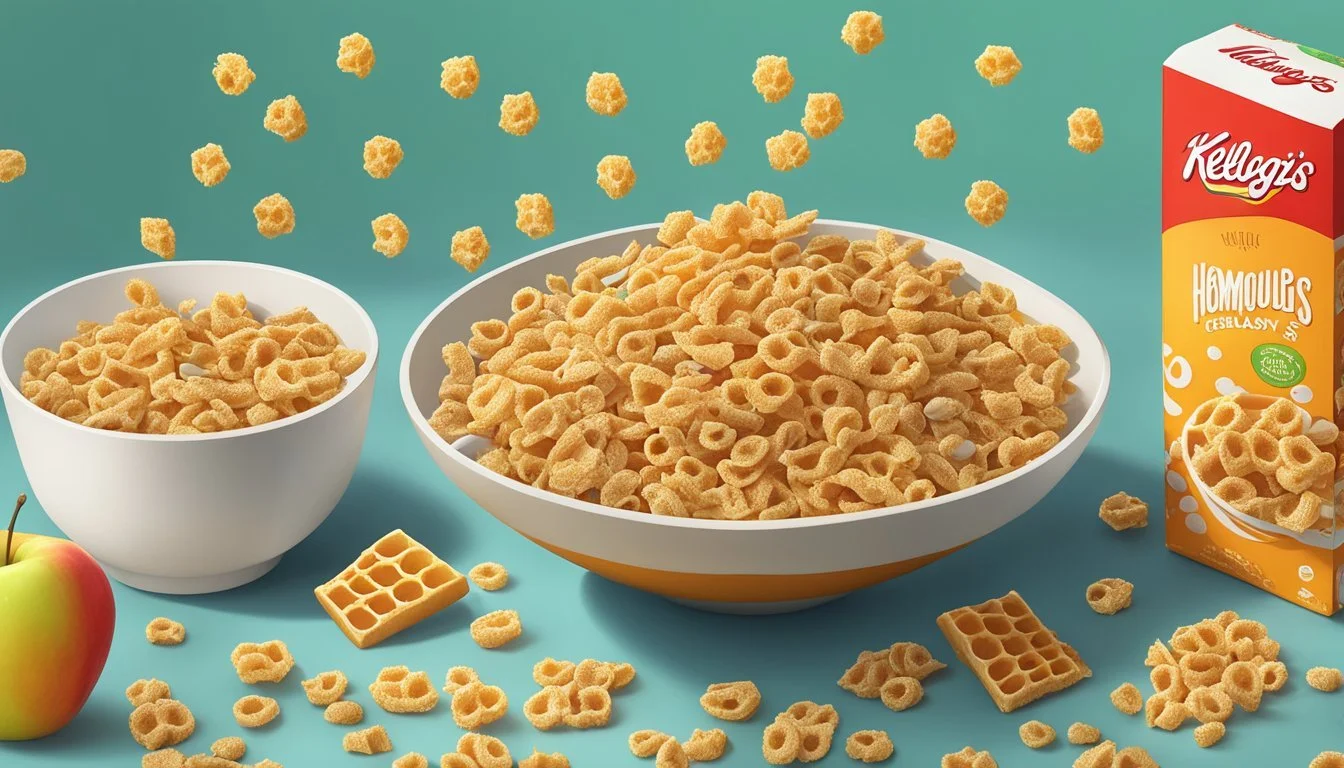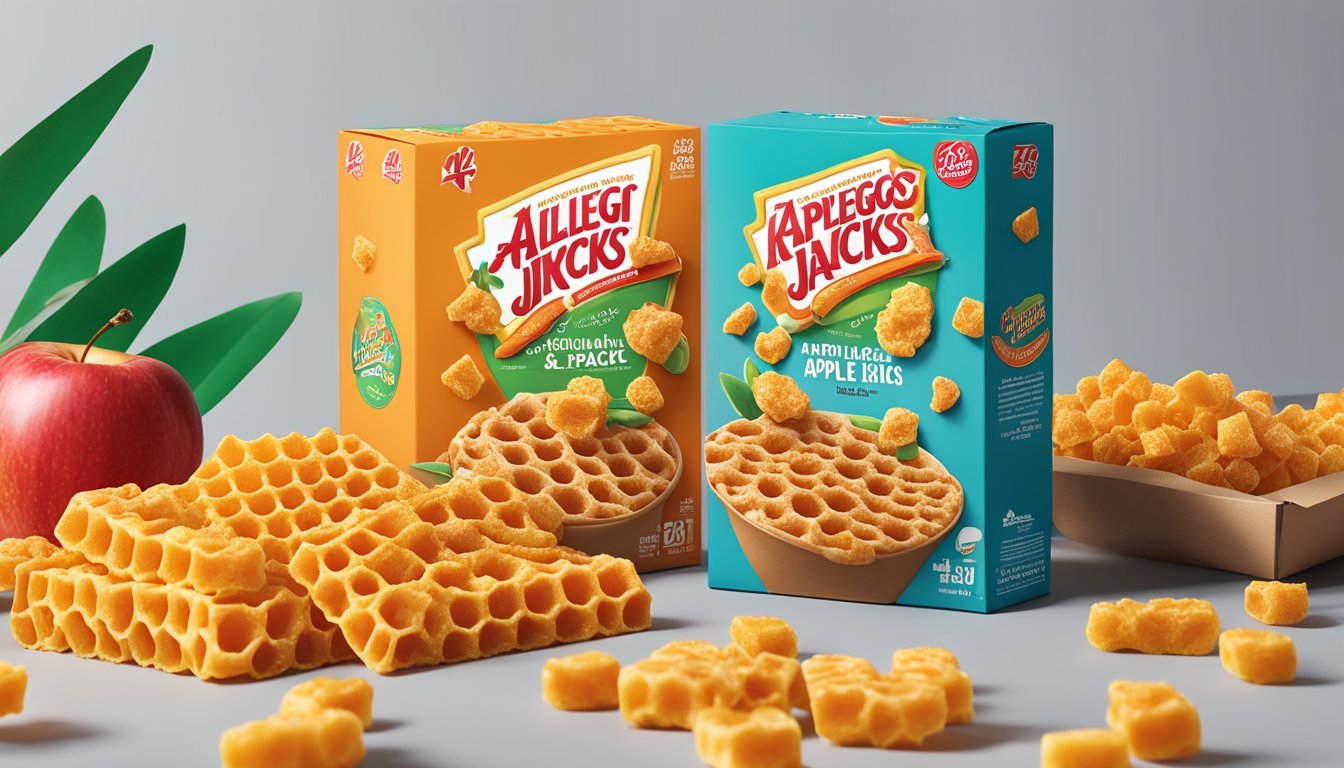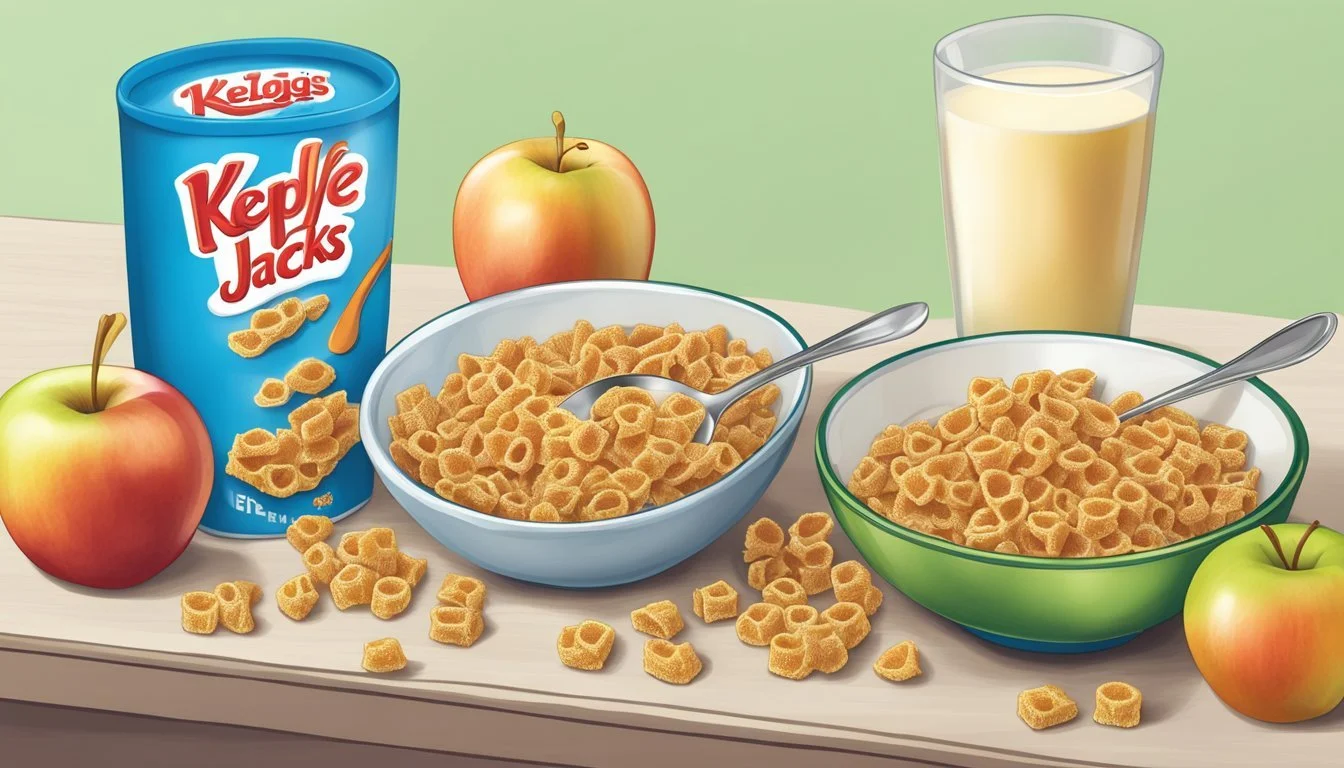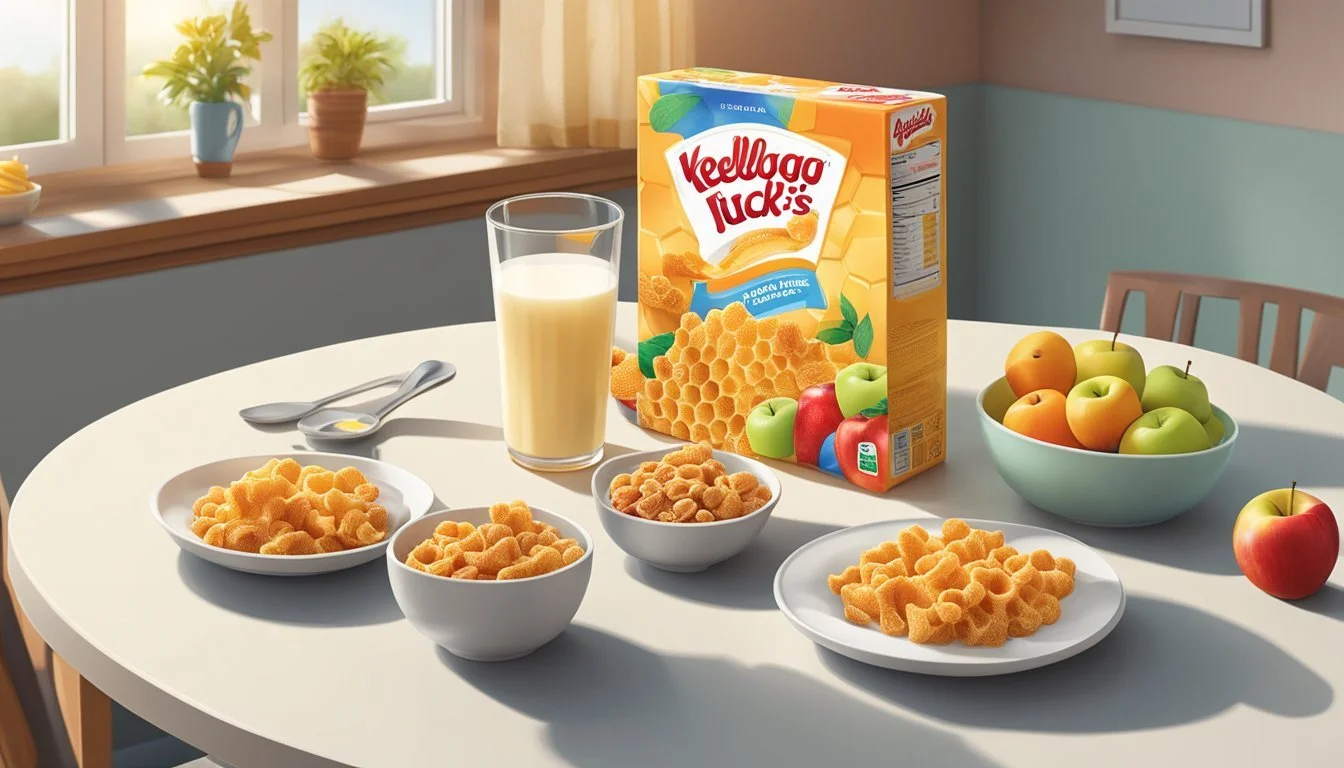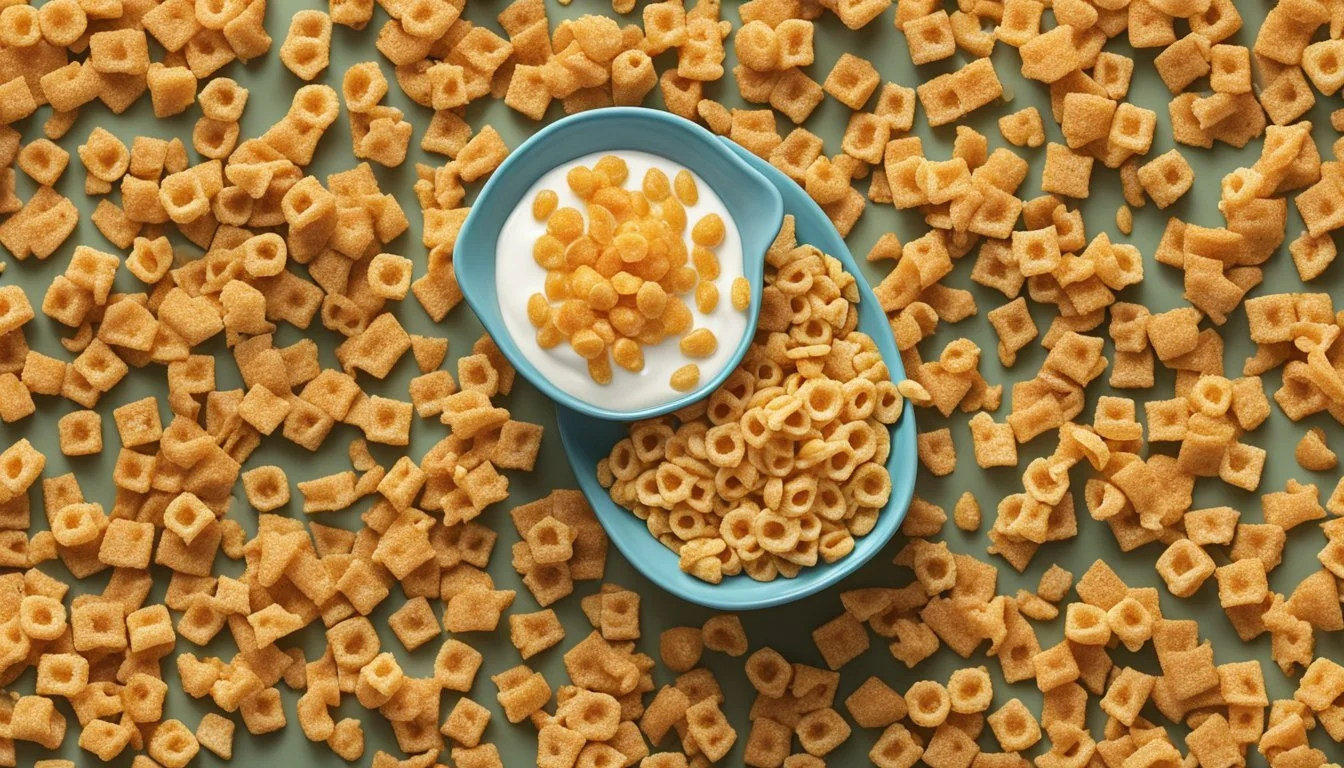Honeycomb vs Kellogg's Apple Jacks
A Comprehensive Cereal Comparison
This Article is Part of Our Breakfast Cereal Guide with Details on Honeycomb Nutrition and Kellogg's Apple Jacks Nutrition
Comparing breakfast cereals can often be a daunting task, especially when choosing between two popular brands like Honeycomb and Kellogg's Apple Jacks. When it comes to nutritional value, Honeycomb Cereal contains twice as much Vitamin D as Kellogg's Apple Jacks. This could make it a preferable choice for those looking to boost their Vitamin D intake.
Kellogg's Apple Jacks, on the other hand, are known for their iron content. They cover a whopping 96% more of the daily iron needs compared to Honeycomb Cereal. Yet, for those wary of sugar, both cereals have a notable sugar content, with Apple Jacks being on the higher end.
Enjoying a bowl of cereal isn't just about nutrition. The taste and experience matter too. Honeycomb offers a unique texture and taste reminiscent of sweet honey, which contrasts with the fruity flavor profile of Apple Jacks. Each brings a distinct pleasure to the breakfast table, making the choice a matter of personal preference.
Overview of Honeycomb Cereal
Honeycomb Cereal is a popular breakfast choice recognized for its unique shape and sweet taste. Discover more about its origins, nutritional value, and key characteristics.
History and Brand
Honeycomb Cereal was introduced by Post Consumer Brands in 1965. The cereal's distinctive honeycombed shape quickly became its trademark. It appealed to children and parents alike due to its playful design and appealing taste.
The brand has maintained its place in the market due to consistent advertising and loyalty programs. Commercials featuring the Honeycomb mascot, Crazy Craving, also contributed to its popularity. This cereal has gone through various recipe changes but has consistently emphasized a crunchy texture and honey flavor.
Nutritional Profile
Honeycomb Cereal provides a range of important nutrients. A typical serving size is 1.33 cups, which contains around 110 calories. The cereal boasts a significant amount of Vitamin D, approximately 313 IU per serving, which is more than many of its competitors like Kellogg's Apple Jacks. This added Vitamin D meets part of the daily requirements for maintaining strong bones and overall health.
The cereal contains about 27 grams of carbohydrates, including 9 grams of sugars. While it provides a moderate amount of fiber, around 1 gram per serving, its sugar content is a point of consideration for those monitoring their sugar intake. The iron content also stands out, contributing to daily nutritional needs.
Distinctive Features
Honeycomb Cereal is easily distinguishable by its large, hexagonal shape, resembling a honeycomb. This unique form isn't just for visual appeal— it adds to the crunchiness, providing a satisfying texture for consumers. The honey flavor is another key feature, derived from real honey, which imparts a natural sweetness.
The cereal's crunchiness makes it popular among children, while the inclusion of essential vitamins and minerals appeals to health-conscious parents. Over the years, the brand has also launched limited-time flavors and versions, such as chocolate honeycomb, to keep up with changing consumer tastes.
Understanding Kellogg's Apple Jacks
Kellogg's Apple Jacks is a popular cereal known for its sweet apple and cinnamon flavors. The following sections will provide a detailed look at the evolution of the brand, its nutritional information, and its signature taste and ingredients.
Brand Evolution
Kellogg's Apple Jacks was introduced in 1965 and has since established a strong presence in the breakfast cereal market. Over the years, the cereal has undergone several transformations in terms of marketing and product design.
Originally known for its round, orange and green pieces, the cereal has experimented with various temporary shapes, including carrots and ghouls, to engage children and parents alike. The brand has also featured a variety of mascots to keep the cereal appealing and recognizable.
Recent marketing efforts continue to build on the cereal’s fun and playful image. Despite changes in shapes and mascots, the core identity of Apple Jacks as a sweet, flavorful breakfast option remains consistent.
Nutrition Information
Apple Jacks offers a balanced combination of vitamins and minerals but is notably high in sugar. A standard serving of one and one-third cups contains around 150 calories.
The cereal includes approximately 13 grams of sugar, 1.5 grams of fat (0.5 grams saturated), 210 mg of sodium, 34 grams of carbohydrates, 2 grams of protein, and 2 grams of fiber.
Though it covers 96% of daily iron needs, it is relatively lower in Vitamin D compared to other cereals. While Apple Jacks may not be the healthiest option, it provides some essential nutrients that are beneficial when consumed in moderation.
Signature Taste and Ingredients
Apple Jacks stands out due to its distinctive apple and cinnamon flavor profile. The primary ingredients contributing to this signature taste include corn flour, wheat flour, and oat flour, blended with sugar and apple juice concentrate.
The inclusion of apple juice concentrate adds a natural sweetness, while cinnamon offers a warm, spicy note. Other ingredients include corn syrup, modified food starch, salt, and vegetable oil.
The cereal’s vibrant colors are achieved using artificial colorants such as Red 40, Yellow 6, and Blue 1. These elements combined create the unique and memorable taste that many people associate with breakfast.
Comparative Analysis
Honeycomb and Kellogg's Apple Jacks offer distinct flavors and nutritional profiles, appealing to different segments including children and adults. These cereals vary significantly in their health benefits, taste, and target audiences.
Flavor Profiles
Honeycomb is known for its unique honey flavor, which is both sweet and mild. The cereal pieces are shaped like honeycombs, giving a fun texture that is appealing especially to children.
Kellogg's Apple Jacks provides a blend of apple and cinnamon flavors. The taste is sweeter and more pronounced, with a distinctive cinnamon undertone. The colorful circular pieces add visual appeal, making it a favorite choice among kids.
Health and Nutrition
Honeycomb is relatively low in calories compared to Apple Jacks. It offers a balanced mix of vitamins and minerals, though it is higher in sugars.
Nutrient Honeycomb Apple Jacks Calories (per serving) 110 110 Saturated Fat 0g 0g Trans Fat 0g 0g Net Carbs 27g 24g Protein 2g 1g
While both cereals are low in saturated and trans fats, Apple Jacks has slightly fewer net carbs. Neither is particularly suitable for low-carb diets. Consider the higher sugar content in both when choosing for a low-sugar diet.
Target Audience
Honeycomb primarily targets children and families looking for a fun, tasty breakfast option. Its honey flavor and unique shape make it enjoyable for younger audiences.
Apple Jacks appeals to those who enjoy a sweeter, more flavorful cereal. The apple-cinnamon combo and colorful appearance are designed to attract kids, but adults with a sweet tooth also favor it.
The choice between Honeycomb and Apple Jacks largely depends on flavor preference and nutritional needs. Each offers unique benefits catering to different tastes and dietary considerations.
Ingredient Breakdown
Honeycomb and Kellogg's Apple Jacks feature distinct ingredient profiles. This breakdown highlights common ingredients, unique additives, and potential allergens associated with these cereals.
Common Ingredients
Sugar is prominent in both cereals, contributing to their sweet taste. Additionally, both contain corn flour blend, which is utilized as a primary grain component.
Salt is used to enhance flavor. Both products also include wheat or wheat derivatives, with Honeycomb specifically using whole-grain wheat and Apple Jacks incorporating wheat flour.
BHT is added as a preservative to extend shelf life, ensuring the cereals maintain freshness over time.
Unique Additives
Honeycomb incorporates ingredients like caramel for coloring and flavoring. This gives the cereal its characteristic golden hue. The formulation also includes honey as a distinctive sweetener, differentiating it from other cereals.
Kellogg's Apple Jacks contains dried apples and cinnamon, providing its signature apple-cinnamon taste. Additionally, Yellow 6, Red 40, and Blue 1 are food colorings used to give Apple Jacks its vibrant appearance.
Apple Jacks uses hydrogenated oils to improve texture and shelf stability.
Potential Allergens
Both cereals contain wheat, making them unsuitable for individuals with gluten intolerance. Consumers allergic to corn or wheat should be cautious when consuming either cereal.
Kellogg's Apple Jacks has dried apples, which might be problematic for individuals with fruit allergies. Additionally, the presence of various artificial colorings (Yellow 6, Red 40, Blue 1) in Apple Jacks can cause reactions in some sensitive individuals.
Honeycomb's use of honey could also be an issue for those with specific sweetener sensitivities.
Chocolate-flavored versions of these cereals might contain ingredients like cocoa and marshmallows, which aren't included in the specific formulations discussed but can be found in some variations, introducing additional allergens.
Marketing and Branding
Both Honeycomb and Kellogg's Apple Jacks have utilized distinct marketing and branding strategies to captivate their target audiences. This section covers key aspects of their advertising campaigns, mascots, and market positioning.
Advertising Campaigns
Honeycomb and Apple Jacks have emphasized different themes in their advertising campaigns. Honeycomb often targets families and children with commercials focusing on the cereal's unique shape and texture. Their advertisements frequently highlight the "big honey taste."
Apple Jacks' marketing campaigns appeal to a slightly older demographic, embedding fun and playful elements in their advertisements. They often use animated characters and vibrant colors to capture attention. Kellogg’s has also invested heavily in digital advertising, targeting teens and pre-teens through webisodes and advergames.
Mascots and Characters
The use of mascots and characters is central to the branding of both cereals. Honeycomb has featured characters like the Honeycomb Kid and Crazy Craving, which appeal to younger children by emphasizing fun and adventure.
Apple Jacks, on the other hand, introduced the Apple Jacks Kids in the 1960s and later evolved to include characters like CinnaMon and Bad Apple. These characters engage children and teens, creating memorable and relatable figures that enhance brand loyalty. The 2000s saw a rebranding effort with animated characters that added a dynamic edge to their advertising.
Market Positioning
Honeycomb positions itself as a family-friendly cereal with a strong emphasis on taste and texture. Their branding revolves around the idea of providing a satisfying and enjoyable breakfast experience that appeals to both children and parents.
Apple Jacks, a product from Kellogg's, leverages its playful image and fun mascot-driven campaigns to position itself as a favorite among children and teenagers. Their marketing strategy often highlights the unique apple and cinnamon flavor combination, setting it apart from other popular cereal brands. They focus on capturing the attention of a slightly older, more independent audience.
Consumer Perspectives
Honeycomb and Kellogg's Apple Jacks are popular breakfast cereals, each offering distinct flavors and cultural significances. Consumer preferences for these cereals often hinge on taste and nutritional factors.
Taste Preferences
Many consumers love the distinct taste profiles of these cereals. Honeycomb has a sweet, honey flavor with a crunchy texture, appealing to those who enjoy a more natural sweetness.
Conversely, Apple Jacks combines apple and cinnamon flavors with a unique crunch, making it a favorite for those who appreciate a fruitier and spicy touch.
Both cereals' sweetness might be attractive to children, although adults sometimes prefer Honeycomb for a healthier breakfast option.
Cultural Impact
Honeycomb and Apple Jacks have both left a significant mark on breakfast culture. Honeycomb, introduced by Post in 1965, has maintained its popularity by appealing to families with its playful marketing.
Apple Jacks, launched by Kellogg's in 1965, gained a strong following by highlighting its unique flavor combination. Creative marketing campaigns have cemented both cereals in the minds of consumers.
These cereals also reflect changes in dietary trends. Honeycomb is often seen as a choice for a low glycemic index diet, while Apple Jacks' apple and cinnamon notes cater to those seeking flavorful, nostalgic breakfasts.
Dietary Considerations
When choosing between Honeycomb and Kellogg's Apple Jacks, it is crucial to consider their nutritional value and potential dietary restrictions. Evaluating these factors helps ensure a well-informed decision that aligns with dietary needs and preferences.
Nutritional Value in Diets
Honeycomb and Apple Jacks both offer a variety of vitamins and minerals.
Honeycomb is particularly high in iron, covering 87% of daily needs. It also contains Vitamin D and zinc, which support immunity and bone health.
In contrast, Apple Jacks provide a significant amount of Vitamin B6, Vitamin B12, and Vitamin C. These vitamins are essential for energy metabolism and immune function. Apple Jacks also contain more potassium, beneficial for heart health.
Both cereals have moderate amounts of calories and sugars, roughly 150 calories and 13 grams of sugar per serving for Apple Jacks. It's important to note the presence of other nutrients like calcium, magnesium, and selenium, which contribute to overall wellness.
Restrictions and Allergies
Both cereals contain gluten, making them unsuitable for individuals with celiac disease or gluten intolerance. Honeycomb lists corn syrup and sugar prominently, which may be a concern for those monitoring sugar intake.
Apple Jacks highlight milk derivatives and might not be ideal for those with lactose intolerance or dairy allergies.
Potential allergens in both include soy and artificial colors. Individuals with allergies to these substances should read ingredient labels carefully. Additionally, the high sugar content in both cereals could be a red flag for those managing diabetes or seeking to reduce sugar intake.
Reviewing ingredient lists and considering personal dietary needs will help determine the best choice.
Related Cereal Products
When comparing Honeycomb and Kellogg's Apple Jacks, it's useful to explore other cereal products in the market. This evaluation will look at comparable cereals, focusing on industry alternatives and similar flavor options.
Industry Alternatives
The cereal industry is filled with various options that serve different tastes and nutritional needs. Cocoa Pebbles and Fruity Pebbles are popular alternatives that offer distinct chocolate and fruity flavors, respectively. Both are well-loved for their vibrant colors and sweet tastes.
Corn Chex and Kix present less sugary options, ideal for those who prefer a more subdued sweetness. Corn Chex offers a crunchy texture that works well in recipes beyond breakfast, like snack mixes. Kix, known for its "kid-tested, mother-approved" slogan, provides a lighter, puffed corn texture with a mild, sweet flavor.
Mueslix caters to the health-conscious, combining whole grains, nuts, and dried fruits. It delivers a nutty taste and a chewy texture, making it a considerably different experience compared to sugar-laden options.
Similar Flavor Options
For those who enjoy the taste profiles of Honeycomb and Apple Jacks, other cereals bring similar flavors to the table. Apple Jacks with Marshmallows enhances the traditional Apple Jacks taste with added sweetness and texture from marshmallows.
Honey Smacks and Golden Crisp both focus on rich honey flavors. Honey Smacks features puffed wheat coated in honey, while Golden Crisp offers a comparable taste experience with a different texture.
Cookie Crisp serves a sweet, cookie-like flavor. Though not directly similar to Honeycomb or Apple Jacks, it appeals to those who enjoy sugary, dessert-like cereals.
These alternatives cater to a range of flavor preferences and dietary considerations, offering something for everyone in the cereal aisle.
Conclusion
When comparing Honeycomb and Kellogg's Apple Jacks, several factors make each cereal unique.
Nutritional Value:
Honeycomb: Contains 120 calories, 10 grams of sugar, 1 gram of fat, and 2 grams of fiber per serving.
Apple Jacks: Contains 150 calories, 13 grams of sugar, 1.5 grams of fat, 2 grams of protein, and 2 grams of fiber per serving.
Sweetened Taste: Both cereals are sweetened, catering primarily to children. Apple Jacks offers an apple and cinnamon flavor, while Honeycomb retains a distinct honey-like taste.
Ingredient List:
Honeycomb: Ingredients include corn flour, sugar, honey, and various vitamins and minerals.
Apple Jacks: Key ingredients include corn flour, wheat flour, sugar, apple juice concentrate, and various vitamins and minerals.
Visual Appeal: Apple Jacks feature a colorful mix of orange and green loops, while Honeycomb highlights its unique honeycomb shape.
Both cereals provide a sweet and enjoyable breakfast option. While Honeycomb emphasizes a honey flavor, Apple Jacks brings a fruity twist with apple and cinnamon. Each has its own set of nutritional benefits and ingredient profiles, making them distinct choices in the cereal aisle.
More on Honeycomb
More on Kellogg's Apple Jacks
Cinnamon Toast Crunch vs Kellogg's Apple Jacks: Which is better?
French Toast Crunch vs Kellogg's Apple Jacks: Which is better?
Honey Nut Cheerios vs Kellogg's Apple Jacks: Which is better?
Kellogg's Apple Jacks vs Kellogg's Froot Loops: Which is better?
Kellogg's Apple Jacks vs Post GrapevsNut Flakes: Which is better?
Kellogg's Apple Jacks vs Post Raisin Bran Cereal: Which is better?

